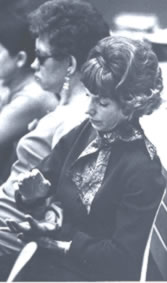When Mae Brown knelt to receive her graduation hood on a drizzly day in June 1972, the hush in Convocation Hall was as thick as the daily silence she had endured for almost 20 years. The audience finally broke into a standing ovation, but, as Canada’s first deaf-blind university graduate, Brown could neither hear nor see the outpouring of emotion for her achievement.
In an article published nine years earlier, Brown explained her motivation for seeking an education and likened her life to “a canyon, deep and dark, to the point of being stifling…. Fresh air and the sunlight of knowledge are high above me, while I stand on the brink of defeat. To remain here would have meant certain death to the human spirit,” she wrote. “Outside this pit was the satisfaction through academic and mental achievement. A difficult climb was the only way to the top.”
Difficult doesn’t begin to describe Brown’s journey to Convocation Hall. She was born seemingly healthy in 1935, but her sight and hearing steadily deteriorated until she was finally diagnosed at age 18 with toxoplasmosis and neurofibromatosis, diseases that disrupt the central nervous system. The diagnoses came after surgeons removed an orange-sized tumour from her brain, leaving her completely deaf (she had already lost her sight).
Yet she never complained about her fate, says Joan Mactavish (BA 1942 Victoria, DLitt Sac. Hon. 2002) – winner of the 2001 Victoria College Distinguished Alumni Award – in her book, Bravo! Miss Brown: A World Without Sight and Sound. Officially, Mactavish was Brown’s 25-hour-per-week tutor through her five years of study at the University of Toronto at Scarborough (then Scarborough College). Brown studied year-round, taking summer courses on the St. George campus. In reality, Mactavish’s hours were immeasurable and her duties countless. These were the days before the concept of accessibility, and Brown flatly refused special treatment.

The pair always sat in the front row of their classes so that a tape recorder could capture every word, which Mactavish would later transcribe and mail to a volunteer, who translated the lectures into braille. During class Mactavish also relayed information to Brown using the two-hand manual-communication method, in which she would spell out the professor’s words using special hand positions on Brown’s palm. This tactile technique was Mactavish’s main method of speaking to Brown during study sessions, essay writing, seminars or tests; Brown had retained her ability to answer verbally.
Every ordinary academic task was an ordeal, with layers of translation from spoken and printed words to manual communication and braille, then back again. One multiple-choice psychology exam, for example, took 15 hours over three days to complete. It was a gruelling, cumbersome process, yet Brown managed to get mostly As and Bs.
Before attending university, Brown had been a maid, craftswoman, sewer and Braille proofreader. These were unsatisfying – some of them hateful – occupations to her. “I would like to find a way of fitting into normal society and to secure a form of better employment,” she wrote to a friend. “I find the need to live rather than to just exist. I am prepared to live up to any expectations if provided with an opportunity.” To her, a full, meaningful life meant getting a degree so that she could help others in her position.
Brown was able to enjoy the rewards of her efforts only briefly after earning her bachelor of arts degree. She worked for just over a year, developing services for the deaf-blind at the Canadian National Institute for the Blind (CNIB) in Toronto, before her death in 1973 at the age of 38. Mactavish, determined not to let Brown’s dreams and achievements die with her, agreed to conduct a study for the CNIB in 1975 on the needs of the deaf-blind in Ontario.
The study’s key recommendations, which Mactavish helped to implement, made several of the services Brown envisioned a reality. Today, instead of learning on the job as Mactavish did, there is a formal training program for “intervenors” for the deaf-blind. A specially designed apartment building in Toronto – the only one of its kind in North America – offers independent living for the deaf-blind in a safe environment with every imaginable aiding device. And just last year, the Canadian Helen Keller Centre opened in Toronto, addressing the need for outreach and training devoted exclusively to the deaf-blind.
Through active involvement in all of these developments, Mactavish has built a permanent legacy for the cherished student she calls “a true Canadian hero.” “Mae was my teacher as much as I was hers,” she says.
Megan Easton is a freelance writer in Kingston, Ontario
Recent Posts
U of T’s 197th Birthday Quiz
Test your knowledge of all things U of T in honour of the university’s 197th anniversary on March 15!
Are Cold Plunges Good for You?
Research suggests they are, in three ways
Work Has Changed. So Have the Qualities of Good Leadership
Rapid shifts in everything from technology to employee expectations are pressuring leaders to constantly adapt







One Response to “ Bravo, Miss Brown! ”
I live in Edinburgh Scotland now. I spent 5 years in Canada working for the CNIB there and was friendly with Mae Brown, she was an inspiration to me. She was always well dressed and had a good sense of humour. I used to have meals with her at the Clarkwood Residence where she stayed. I am of course sighted as I worked in the Secretarial Department there. Greetings to any ex-employees (I am going back 40 years now) and am an OAP! Or do they say in Canada Senior Citizen.